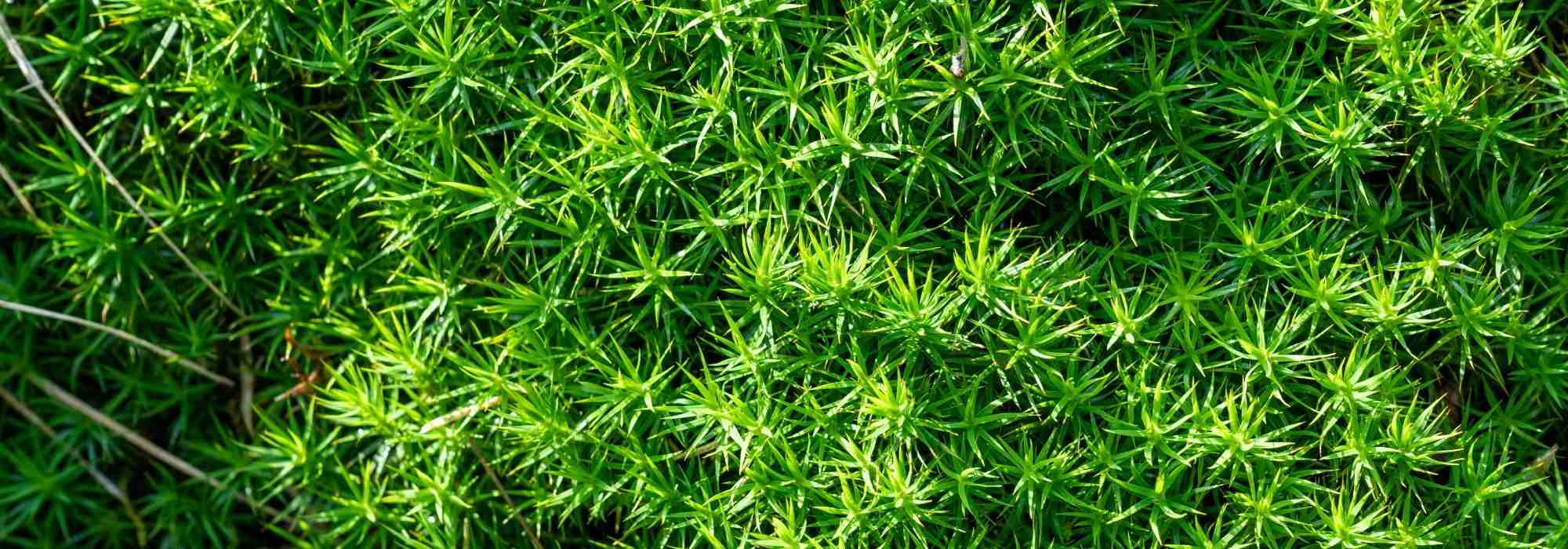
Sagina, Sagina subulata: planting, care, uses
Contents
Sagina in a nutshell
- Sagina is a perennial groundcover plant that forms an evergreen lawn
- This “carpet plant,” beautiful all year round, is ideal for greening gravel paths that are not too dry or as a substitute for lawn
- In spring, its mossy foliage is covered with tiny white flowers
- Easy to grow, hardy and low-maintenance, it prevents weeding in lightly trodden areas
- Avoiding heat and drought, it should be reserved for cool, shaded spots
A word from our expert
The Sagina, Sagina subulata, or subulate sagina, is a small evergreen perennial groundcover that resembles moss and lawn. With its lovely fine and dense foliage, it forms a low, soft, and fluffy carpet, earning it the nickname “carpet plant”! It remains compact, not exceeding 5 cm in height, and stays green throughout the seasons.
This mossy carpet is adorned with a multitude of tiny white flowers at the end of spring.
It easily slips between the slabs of a Japanese path, the gaps in walls, in a rockery, or can replace lawn in areas of the garden that are lightly trafficked and where grass refuses to grow. This is why sagina is often available in rolls or slabs.
Low maintenance, it does not require mowing.
Like helxine, sagina is a valuable alternative to lawn in shaded areas as it dislikes overly dry soils.
Discover this groundcover that looks beautiful even in winter, perfect for covering cool soils!
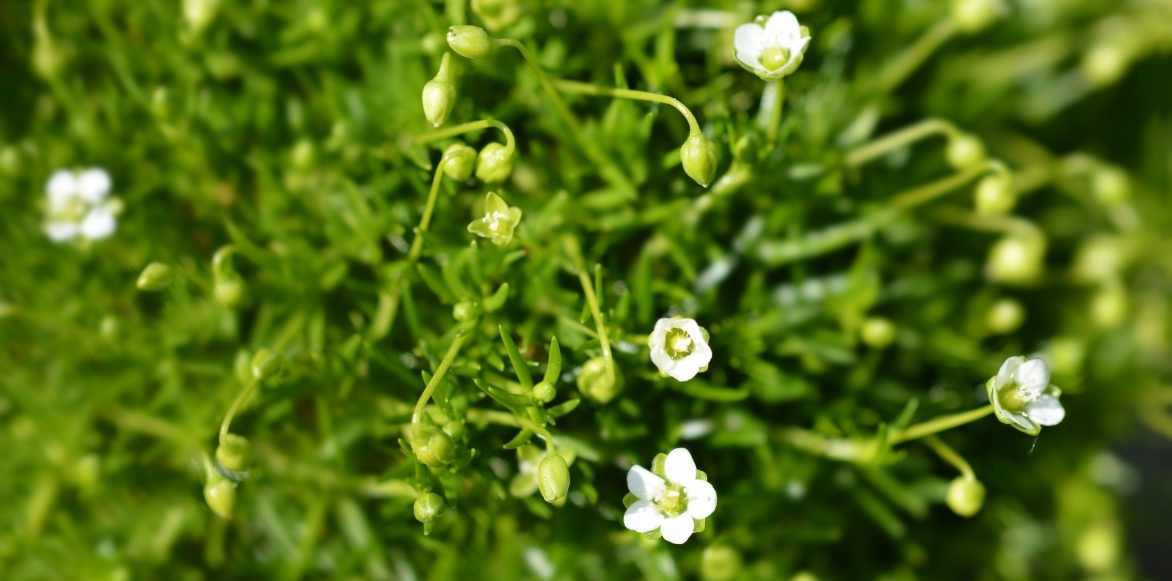
Description and Botany
Botanical data
- Latin name Sagina subulata
- Family Caryophyllaceae
- Common name Pearlwort
- Flowering May to August
- Height 3 to 10 cm
- Sun exposure Sun, partial shade
- Soil type Light, cool, well-drained
- Hardiness –15 °C
Pearlwort, Sagina subulata, or subulate pearlwort, is a small evergreen groundcover perennial belonging to the Caryophyllaceae family, just like the carnation. The genus comprises about twenty species native to Western Europe and temperate regions of the Northern Hemisphere. Sagina subulata is the most commonly cultivated species.
The plant is somewhat slow to establish. It spreads rather slowly as a persistent groundcover, reaching a height of 3 to 5 cm, with an approximate spread of 25 cm. Using tiny stoloniferous and ramified stems, it roots in various places to form a very low carpet, with small cushions resembling moss, hence its other nickname “Irish moss.”
It develops to form a uniform carpet that can replace grass in lightly trafficked areas of the garden. Its thin, running stems, measuring 3-8 cm long, bear small linear and pointed leaves about 1 cm long arranged in pairs. They are bright green in the typical species, while Sagina subulata ‘Aurea’ is a very attractive form with golden foliage.
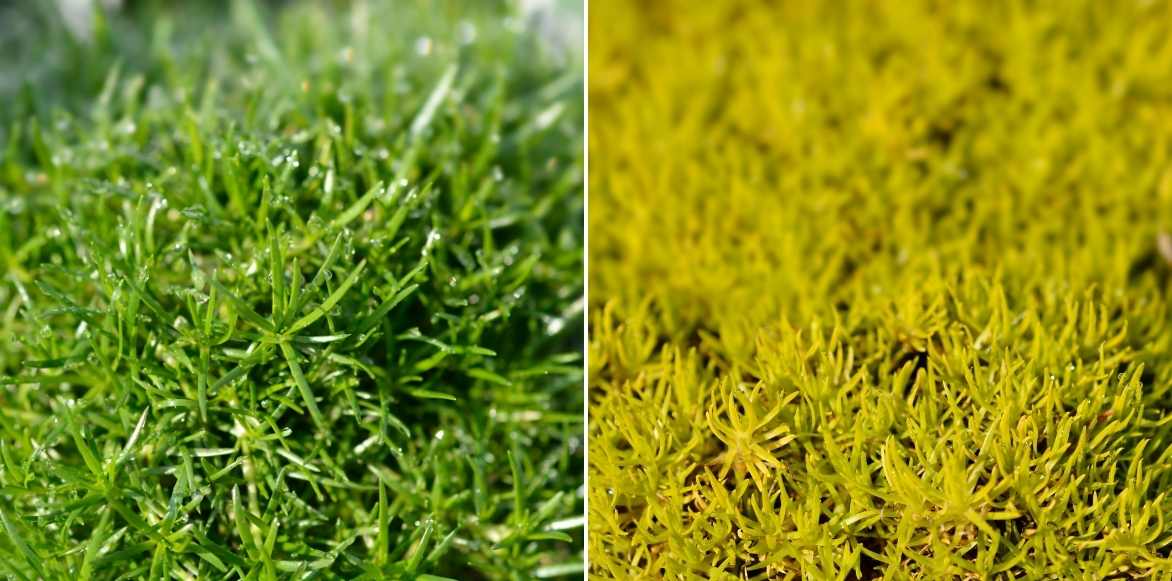
Sagina subulata and Sagina subulata ‘Aurea’
From May to August, depending on the regions, tiny solitary white flowers bloom on this mossy carpet. They measure 4 mm in diameter and consist of 4 to 5 rounded petals. Carried by long axillary or terminal peduncles, they stand out well above the foliage. Each flower releases a bouquet of stamens. This simple white flowering resembles that of strawberries and attracts pollinators. The flowers then transform into tiny open capsules containing seeds that readily self-sow in cool soil. These new seedlings allow the plant to gain ground.
Subulate pearlwort is an excellent alternative to grass in slightly neglected areas of the garden as it does not require mowing but does not tolerate heavy foot traffic well. Remaining green all year round and maintaining a neat appearance, it is also a species appreciated in mosaiculture for creating patterns or scenes of greenery.
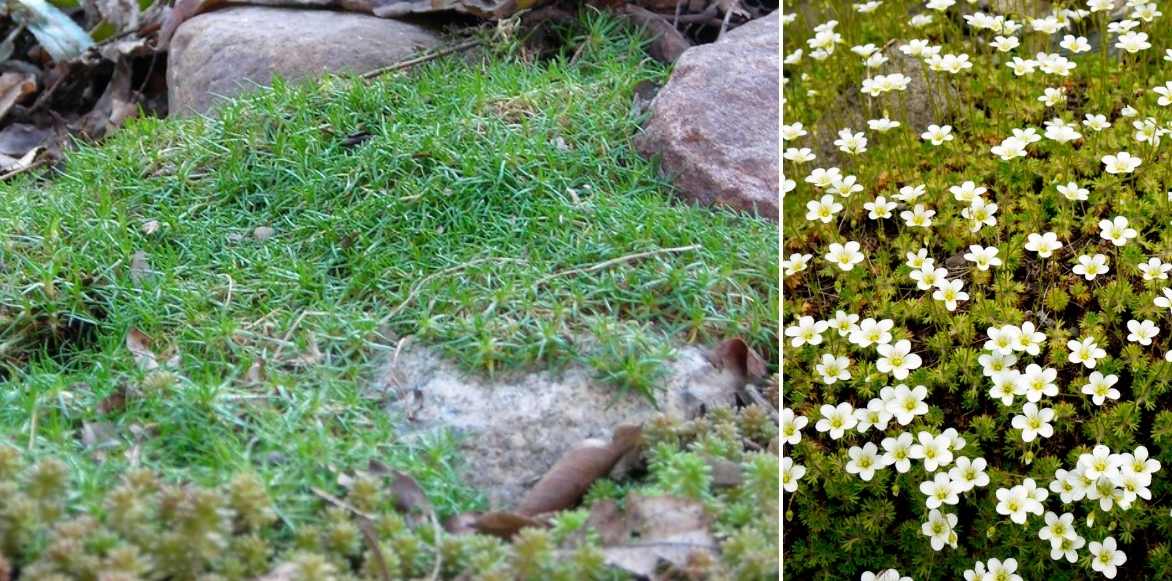
Sagina subulata between stones (© PeterHoh), and the flowering in a myriad of small flowers on the right
Species and varieties
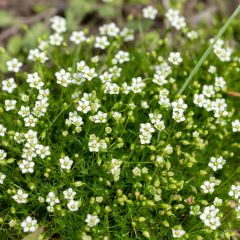
Sagina subulata
- Mois de floraison June, July
- Hauteur à maturité 5 cm
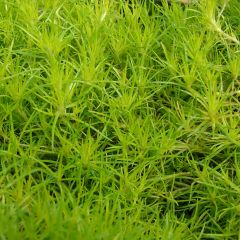
Sagina subulata 'Aurea'
- Mois de floraison June, July
- Hauteur à maturité 5 cm
Sowing Sagina
Where to Plant It?
Perfectly hardy down to -15°C, Sagina subulata withstands cold better than drought. It does not appreciate very dry soils at all; its cultivation proves more challenging in warm climates. It thrives in a sunny position in cool climates and if the soil is moist, or slightly shaded at least during the hottest hours of the day, even in full shade in regions south of the Loire. The carpets will expand over time in light, humus-bearing soil that remains cool, neutral to acidic. It requires naturally moist soil to maintain its vibrant green colour.
It fits into the gaps between paving stones and walls, enriches a cool rock garden, highlights the edge of a flowerbed, or can serve as a verdant backdrop in a perennial bed where it will prevent weeds from establishing. It can also be planted in a Japanese or Zen garden to create graphic scenes, such as in a pot.
This very low and dense groundcover can replace lawn in less frequented areas and is perfect for covering bare spots. Once established, Sagina also helps limit the proliferation of adventive plants.
When to Plant Sagina?
Planting should be done in early autumn or spring, outside of frost and drought periods.
How to Plant Sagina subulata?
In Open Ground
Count at least 8 plants per square metre, spaced 20 cm apart in all directions for a well-homogeneous carpet: they will surely fill the gaps! The soil must be well loosened, free of weeds and stones. Add sand at planting to improve drainage if necessary.
- Dig a hole 2 to 3 times wider than the root ball
- Create a drainage layer
- Place the plant in the centre of the hole
- Cover the root ball with 3 parts gravel or coarse sand and 1 part turf or leaf mould
- Firm the soil
- Water generously and then regularly until it establishes
Between Slabs
Plant directly in moist sand, placing stem sections 10 cm apart, or prefer direct sowing from May to August.
In Pots
In pots, it is essential to keep the substrate moist, especially in summer, or risk this perennial drying out and perishing. Plant it in a well-draining mix of sand and leaf mould.
Read also
Lawn replacement: ideas and solutionsCultivation and Maintenance
Once well established, the young plant requires virtually no maintenance: it does not need mowing, only requiring generous and regular watering during periods of drought and high heat. Water regularly in the first year following planting to help it settle in well. Potted young plants should be watered regularly, especially in summer; the soil should never dry out between waterings. Weeds should be removed regularly from around its base.
If you wish to limit its spread, as it can become invasive when happy, manually remove the excess running stems.
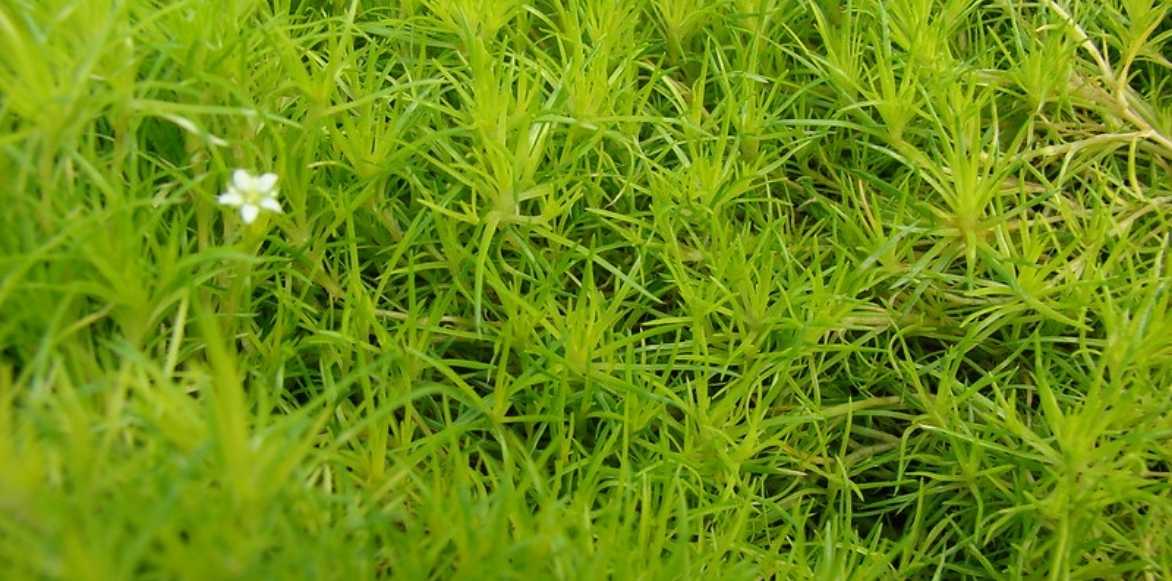
Sagina subulata (© Forest and Kim Starr)
Possible diseases and pests
Only potted plants can be sensitive to red spider mites: ensure adequate ventilation and regularly mist the foliage with water as these mites dislike humidity.
Multiplication
Multiplication by clump division or, more simply, by taking rooted stolons is very easy.
By division
- In early autumn in mild climates or in spring, use a fork to lift part of the clump
- Divide it into several sections, each with roots and leaves
- Replant immediately in the garden or in a pot with suitable substrate
By taking roots
You can also dig up the naturally rooted stems to replant them further away in moist, sandy soil.
Garden Associations
Dressed in green all year round, the subulate sagina is perfect for filling gaps in paving, within a fresh and sunny rockery, or to dress the base of perennials or bushes. Its vibrant green colour enhances the brilliance of bright flowers, revealing the fresh hues of spring bulbs like tulips, or providing a backdrop for hardy fuchsias. At the edge of woodlands, plant it alongside ferns, hostas, terrestrial orchids, and hardy geraniums. To create a carpet of varied colours and textures, combine it with Ruine-de-Rome (Cymbalaria muralis) and heucheras.
It can be used to carpet the base of heather soil bushes (camellias, rhododendrons) that have the same cultural requirements, as it appreciates a certain acidity in the soil. Paired with wild perennials, such as Agrimonia eupatoria ‘Alba’ and Peucedanum ostruthium ‘Daphnis’, it is ideal for covering bare soils.
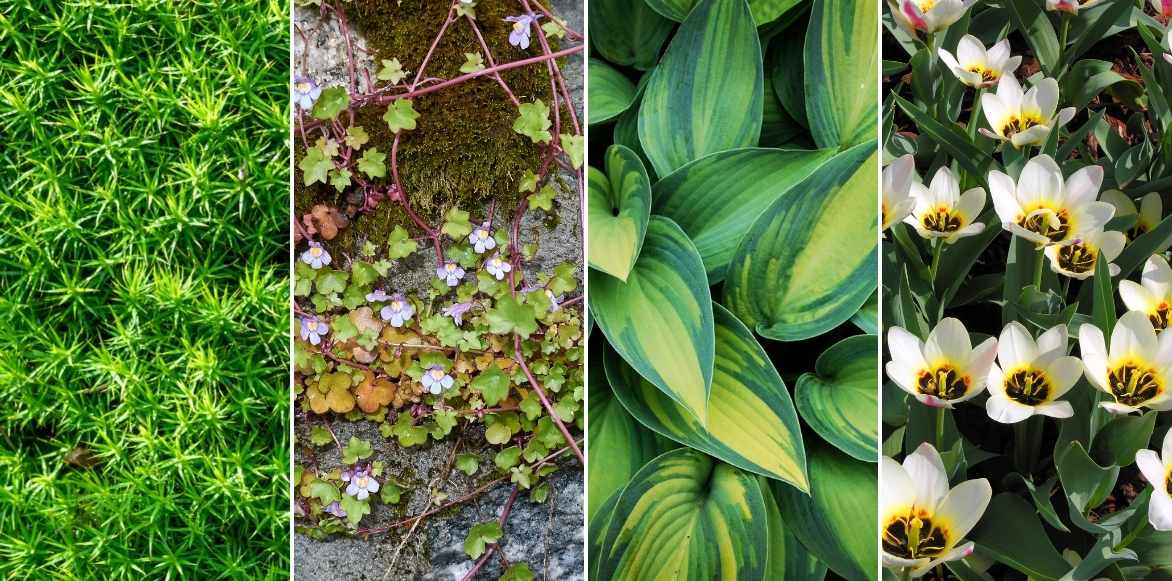
Combine the sagina with Ruine de Rome, hostas, and a carpet of botanical tulips
Useful resources
- What good groundcover as an alternative to lawn?
- Subscribe!
- Contents































Comments